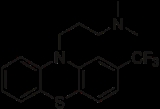
Triflupromazine
Encyclopedia
Triflupromazine is an antipsychotic
medication of the phenothiazine
class. Among different effects of triflupromazine indication for use of this drug is severe emesis. Due to its potential side effects (triflupromazine has higher risk for side effects than many other antipsychotics) it is not gold standard in antiemetic therapy.
Serious side effects of trifluproamzine can be akathisia
and tardive dyskinesia
as well as the rare, but potentially fatal, neuroleptic malignant syndrome
.
and chlorpromazine
, triflupromazine (2-trifluoromethyl-10-(3-dimethylaminopropyl) phenothiazine) is synthesized by the alkylation of 2-trifluoromethylphenothiazine using 3-dimethylaminopropylchloride in the presence of sodamide base.
Antipsychotic
An antipsychotic is a tranquilizing psychiatric medication primarily used to manage psychosis , particularly in schizophrenia and bipolar disorder. A first generation of antipsychotics, known as typical antipsychotics, was discovered in the 1950s...
medication of the phenothiazine
Phenothiazine
Phenothiazine is an organic compound that occurs in various antipsychotic and antihistaminic drugs. It has the formula S2NH. This yellow tricyclic compound is soluble in acetic acid, benzene, and ether. The compound is related to the thiazine-class of heterocyclic compounds...
class. Among different effects of triflupromazine indication for use of this drug is severe emesis. Due to its potential side effects (triflupromazine has higher risk for side effects than many other antipsychotics) it is not gold standard in antiemetic therapy.
Serious side effects of trifluproamzine can be akathisia
Akathisia
Akathisia, or acathisia, is a syndrome characterized by unpleasant sensations of inner restlessness that manifests itself with an inability to sit still or remain motionless...
and tardive dyskinesia
Tardive dyskinesia
Tardive dyskinesia is a difficult-to-treat form of dyskinesia that can be tardive...
as well as the rare, but potentially fatal, neuroleptic malignant syndrome
Neuroleptic malignant syndrome
Neuroleptic malignant syndrome is a life- threatening neurological disorder most often caused by an adverse reaction to neuroleptic or antipsychotic drugs...
.
Chemistry
In an analogous manner to what has already been seen for the preparation of promazinePromazine
Promazine is a medication that belongs to the phenothiazine class of antipsychotics. An older medication used to treat schizophrenia, it is still prescribed, alongside newer agents such as olanzapine and quetiapine...
and chlorpromazine
Chlorpromazine
Chlorpromazine is a typical antipsychotic...
, triflupromazine (2-trifluoromethyl-10-(3-dimethylaminopropyl) phenothiazine) is synthesized by the alkylation of 2-trifluoromethylphenothiazine using 3-dimethylaminopropylchloride in the presence of sodamide base.
- J. Bernstein, F. Sowinski, (1956).
- G.E. Ullyot, (1960).
- Smith Kline & French Lab., (1959).
- B. Duhm, L. Koester, W. Maul, H. Medenwald, Z. Naturforsch., 13, 756 (1958).

